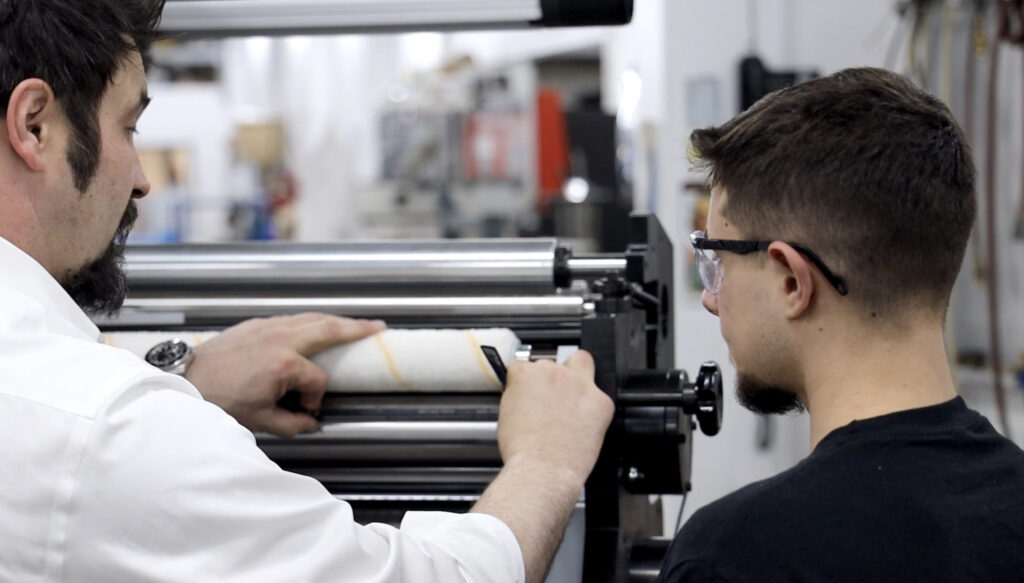Flexographic label printing stands as a cornerstone in the packaging and labeling industry, heralding a blend of versatility, efficiency, and high-quality output. This printing technique, known for its adaptability to a wide range of substrates and its capacity for high-speed production, has evolved significantly over the years. With advancements in equipment, substrates, and embellishments, flexography has solidified its position as a preferred method for producing vibrant, durable labels.
This comprehensive exploration delves into the nuances of flexographic printing, offering insights into its machinery, materials, and the creative possibilities it unlocks, culminating in an overview of how Tamarack’s converting equipment enhances flexographic label printing processes.
The Essence of Flexographic Printing
Flexography combines features of both letterpress and rotogravure printing as a form of rotary web letterpress that utilizes flexible relief plates for printing on various substrates. Its versatility makes it suitable for a broad array of products, including food packaging, labels, and large-scale banners. The core of flexographic printing lies in its ability to produce high volumes of quality prints at rapid speeds, a trait particularly beneficial in the fast-paced consumer goods sector.
Innovations in Flexographic Equipment
The evolution of flexographic printing equipment has been pivotal in its growth. Modern flexographic presses are marvels of engineering designed for precision, efficiency, and sustainability. These presses come equipped with features such as advanced gear systems, sleeve technology for rapid changeovers, and computerized controls for consistent quality.
Innovations like servo-driven presses have further enhanced print quality, allowing for finer detail and consistency across long runs. Moreover, integrated systems that combine printing with in-line converting processes like die-cutting, laminating, and foil stamping streamline production, reducing lead times and waste.
Substrates for Every Need
Flexography’s adaptability to a wide range of substrates is one of its standout features. From traditional materials like paper and film to more sustainable options like biodegradable plastics and recycled content papers, flexography can handle it all. The choice of substrate significantly impacts the print’s appearance, functionality, and sustainability.
As the industry leans towards more eco-friendly practices, the development of substrates that can meet these demands while maintaining high print quality is a key focus area. Advances in substrate technology also mean that flexographic printing can now achieve results once thought only possible with other printing methods.
Embellishments and Finishing Touches
The ability to add embellishments directly within the flexographic printing process enhances the aesthetic appeal and functionality of labels. Techniques such as cold foil stamping, embossing, and varnishing can be integrated into the printing process, adding value and distinction to the final product. These embellishments not only elevate the brand presence on the shelf but also can provide additional functionality, such as tamper evidence or enhanced durability.
Sustainability in Flexography
Sustainability has become a critical consideration in flexographic printing, with efforts focused on reducing waste, using renewable resources, and improving energy efficiency. Advances in plate technology, such as photopolymer plates that require less energy and produce fewer emissions during manufacturing, contribute to a more sustainable printing process.
Additionally, water-based inks, which are less harmful to the environment than solvent-based alternatives, are increasingly used in flexographic printing, aligning with the industry’s green initiatives.
Tamarack’s Contribution to Flexographic Label Printing
At the forefront of supporting the flexographic industry’s evolving needs, Tamarack® Products offers a range of converting equipment designed to enhance the efficiency and capabilities of flexographic label printing. Our solutions, including the innovative P500 RFID Inlay Insertion Equipment, are tailored to meet the demands of modern label production, from integration with existing flexo presses to support the incorporation of advanced RFID technology.
Tamarack’s converting equipment is engineered for seamless integration into flexographic workflows, enabling printers to expand their service offerings and improve productivity. Whether it’s window patching, RFID inlay insertion, or custom converting solutions, Tamarack’s machinery is built to deliver precision, reliability, and versatility. Our focus on developing equipment that meets the highest standards of quality and innovation ensures that flexographic printers can tackle the challenges of today’s market, from short runs and complex designs to sustainability requirements.
Flexographic label printing continues to thrive, driven by advancements in equipment, substrates, and embellishments. This printing method’s inherent flexibility, coupled with ongoing innovations, positions it as a key player in the packaging and labeling industry. Tamarack Products stands alongside these advancements, offering converting equipment that empowers flexographic printers to push the boundaries of what’s possible.
By enhancing operational efficiency, expanding capabilities, and embracing sustainability, Tamarack supports the industry’s progression toward a future where quality, speed, and environmental responsibility go hand in hand. Contact us to explore how Tamarack’s converting equipment can elevate your flexographic printing processes. Let us help you unlock new potentials in label production and beyond.





